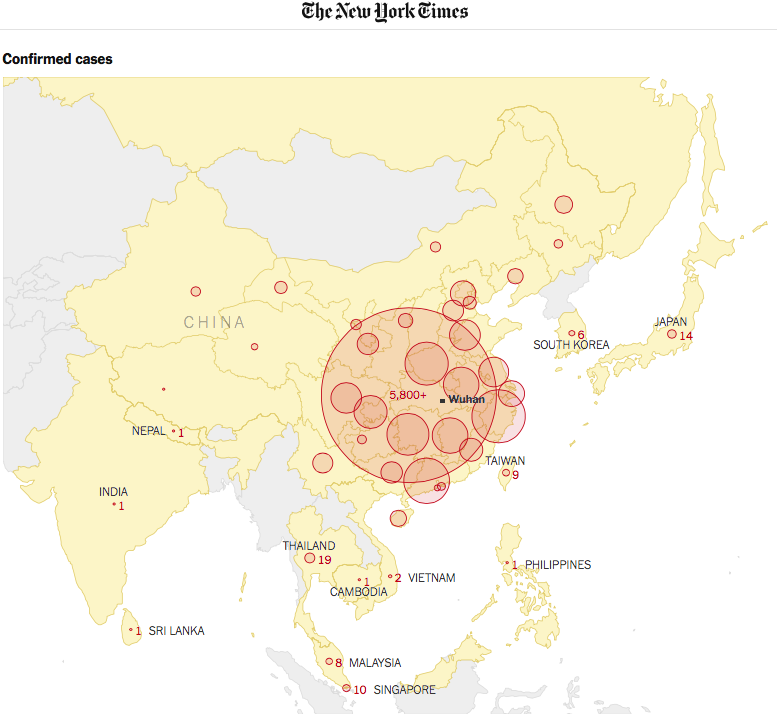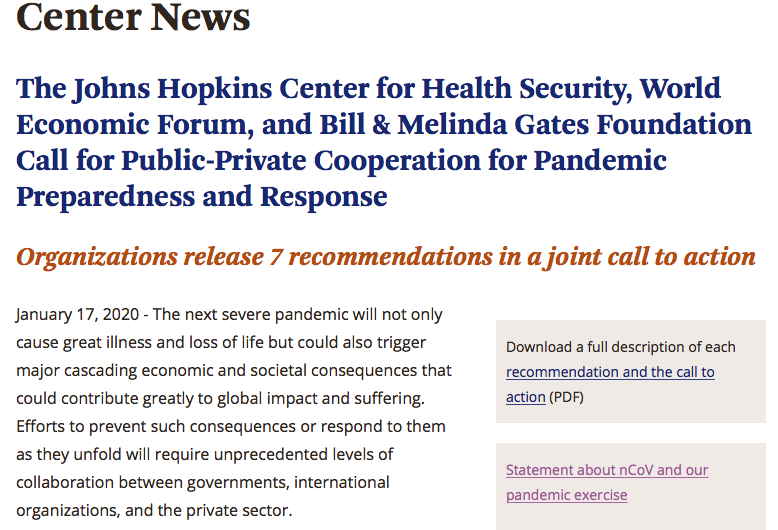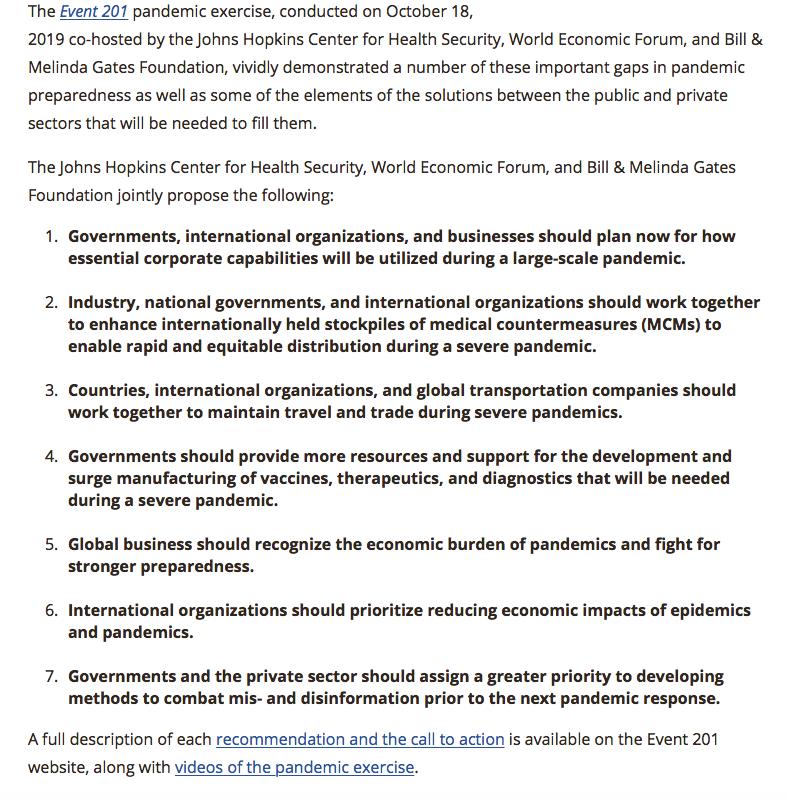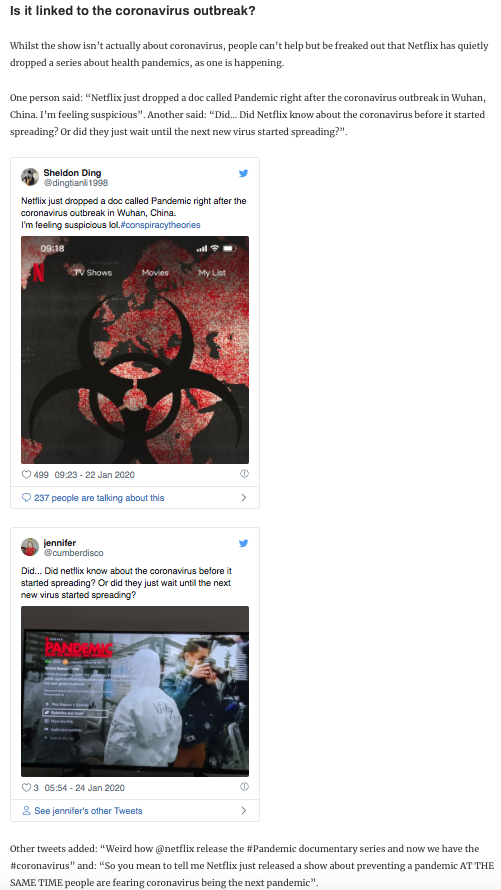
While this coronavirus is indeed serious and is causing deaths, one wonders if the responses, especially in the West, are reaching out of control.
Canada, with a population about the same as Shanghai, has so far this flu season had more than 20,000 confirmed cases, 2,200 hospitalisations, and 85 deaths, roughly the same as all of China with the new corona virus at the same time. But there is no panic in Canada about the flu, and United Airlines isn’t cancelling all flights to Canada.
By the same token for the US in this flu season, there have been 140,000 hospitalisations and about 8,500 deaths.
But the flu barely rates a mention in the US media and the government is not shuttering cities or air travel. Even more, in 2017, the US recorded 61,000 fatalities from the flu with 45 million becoming very ill, yet there was no national emergency cited and life remained normal. (1)
Infection History (December 31, 2019 – January 31, 2019
- December 31 – 1
- January 03 – 44
- January 21 – 225
- January 23 – 830
- January 24 – 1,295
- January 25 – 1,950
- January 26 – 2,744 infections, 80 deaths
- January 27 – 4,515 infections, 105 deaths
- January 28 – 5,974 infections, 132 deaths
- January 29 – 7,711 infections, 170 deaths
- January 30 – 9,692 infections, 216 deaths
- January 31 – 9,800 infections, 216 deaths
Source: Chinese Government and World Health Organization data
See Map Below
scan of NYT map, January 31st
Approximately 150 infections have been recorded outside China in 20-21 countries out of a total of recorded infections of the order of 10,000 (January 31st).
Sofar all recorded deaths are in mainland China. Not a single death has been recorded outside China.
These numbers are low when compared to those pertaining to the common seasonal virus flu outbreak.
According to WHO data, there were 5 million infections and 650,000 deaths Worldwide associated with the common seasonal flu virus. (2017 figures)
In Hong Kong, there are more deaths every two weeks from the regular flu each year (and this year) than occurred with SARS in total, but with only 6 confirmed coronavirus cases, Hong Kong is shutting down most flights and trains between the Mainland and has closed many of its border ports of entry.
In Mainland China, the new virus has now caused more infections than did SARS during 2002-2003, although the death rate is much lower, but 200 or 300 deaths in a population of nearly 1.4 billion is not immediately reminiscent of the plague or the Spanish flu, both of which caused millions of deaths around the world.
And indeed China as well experiences many more deaths from the simple flu each year, yet China has allocated nearly 30 billion RMB (about US$4 billion) to support the battle against this novel coronavirus. The fear and the over-reaction (if indeed it is such) appear to stem simply from the fact that this pathogen is new.
Train travel during this holiday was down by about 75% from the same period last year. China extended the country’s New Year holiday in an attempt to permit citizens to remain isolated at their homes for a longer period, but there will soon be a large wave of travelers returning to their place of residence or work, with the dangers of further infections.
Airlines from numerous countries announced the reduction or full cancellation of all flights to China, and Russia, Mongolia and North Korea blocked all crossings into China until March 1, Russia effectively closing its 4,200 Km border. The US and many other nations have recommended the avoidance of any travel to China. As well, many businesses in China have elected to temporarily close their doors, including Starbucks and McDonald’s, IKEA and others. (2)
The Italian government declared a state of emergency in an effort to “allegedly” prevent the spread of the coronavirus strain after two cases were confirmed in Rome. Italy, Air France, Delta Airlines, Air Canada, British Airways, Lion Air and Seoul Air, Finnair, Cathay Pacific and Jetstar Asia have suspended all flights to and from China. Several other airlines including were reducing the number of flights to the country as demand for travel drops.
Many nations have now evacuated most of their diplomatic staff from China, including the US, France and Japan.
Australia said it would quarantine suspected infections for two weeks on a small island about 1,600 Kms from its mainland, and Singapore has barred all travelers who have visited mainland China during the past two weeks. (3) Elsewhere, more than 6,000 tourists were under lockdown aboard a cruise ship at an Italian port on Thursday after two Chinese passengers from Macao were isolated over fears they could be carrying the coronavirus. (4)
The WHO Declared a Global Emergency
On January 30, the WHO declared the virus outbreak as a global emergency, an “extraordinary event” that constitutes a risk to other countries and requires a coordinated international response. This was prompted by the rapid rise in reported infections, especially having spread to 18 other nations where there were cases of human-to-human transmission. France confirmed that a doctor who was in contact with a patient with the new virus later became infected himself, and medical specialists worry that the spread of new viruses from patients to health workers can signal the virus is becoming adapted to human transmission and thus become much more infectious. (5)
The WHO Director-General said the declaration was not a vote of non-confidence in China, nor what was happening in China, but because of what is happening in other countries, and that “Our greatest concern is the potential for this virus to spread to countries with weaker health systems which are ill-prepared to deal with it.”
Marion Koopmans, an infectious diseases specialist at Erasmus University Medical Center in the Netherlands and a member of WHO’s emergency committee wondered if the virus was “more infectious than previously thought or if there was something unusual in those circumstances”. Another virologist suggested the transmission was easier than initially assumed, stating that “If transmission between humans was difficult, then the numbers would have plateaued”. Another medical officer stated that this new virus “has spread at unprecedented scale and speed, with cases passing between people in multiple countries across the world.”
There were Western media reports that Wuhan medical authorities had been arrested for breaking the news about the virus, but those claims were not true. What did happen was that some unrelated individuals circulated online comments that SARS had returned to China and had been detected in Wuhan’s hospitals, which claim rattled a great many people. The police did interview them because spreading unfounded or false rumors that upset public stability is a crime in China. However these 8 individuals were released and later commended because their evidence proved to be essentially correct even though, as the chief epidemiologist at the CCDC stated, they “lacked scientific evidence”. In fact, China’s Supreme Court issued a statement on this, saying “Facts show that, although the novel coronavirus-infected pneumonia was not SARS, information released by the eight people was not entirely fabricated.” (6)
In a surprising move, the mayor of Wuhan, Zhou Xianwang said that the public were initially unsatisfied with the speed of information disclosure, and that the rapid effective lockdown of the city was upsetting to many people. He said,
“I hope the public can understand that it’s an infectious disease, and . . . It’s unprecedented to lockdown a city with more than 10 million people. However, faced with the current situation, we’ve closed the city gate and possibly besieged the virus within the city. We might leave a bad name in history.”
He then stated “But if it’s conducive to the control of the virus and the protection of the safety of the people”, both he and the party chief in Wuhan would resign if that would appease any existing indignation. (7) Typically, Hong Kong’s South China Morning Post (an anti-Mainland publication) twisted the story to read “Wuhan mayor under pressure to resign over response to virus”, when in fact there was no outside pressure. (8)
It was heartwarming that privately-owned Chinese hotels in Wuhan voluntarily provided free rooms for medical staff needing rest. Xiao Yaxing, the private owner of a four-star hotel in the city, opened a discussion group on Chinese social media platform WeChat where he appealed to his peers from more than 40 hotels to offer rooms for doctors and nurses who were working day and night to save lives. He said that since nearly all transportation had ceased in the large city, it was difficult for the medical staff to get to hospitals from home and needed rest places as well. Xiao said “Many hotels in Wuhan are shut down for travelers, leaving a lot of empty rooms that we can offer for free.” (9)
China’s state-owned enterprises also mobilised their resources to combat the outbreak of pneumonia caused by the novel coronavirus. The nation’s major telecom operators initiated emergency responses to ensure effective communications in Hubei Province, and SOE pharma companies have made extreme efforts to accelerate production of test kits and medical appliances, as well as working around the clock to develop vaccines against the virus. (10)
And of course, every silver lining has a cloud. Retail giants Carrefour and Wal-Mart are being fined millions of RMB for illegal price-gouging, profiteering frauds, and “otherwise cheating” their customers during this crisis, both having apparently been warned in advance only a few days prior by the authorities and both firms ignoring the warnings. It must be said that both Carrefour and especially Wal-Mart have a long history in China of various kinds of fraudulent practices. A few years ago, all the Wal-Mart stores in Chongqing Province were shuttered and six top executives arrested for a massive public fraud, with the company receiving a heavy fine. (11)
As an example in this instance, one branch alone of Carrefour in Shanghai had taken advantage of the public anxiety to mark up their regular vegetable prices from (for example) 2.5 RMB to 19.8, from 3.87 to 19.55, and from 4.26 to 18.33, while their procurement costs had remained stable. The authorities discovered that both Carrefour and Wal-Mart had been further cheating customers with false prices or misleading tags but charging 30% to 50% more at the check-out. These price frauds occurred in many stores in many provinces by both firms. (12)
Carrefour China apologized for any pricing irregularities and said the company would establish “a special control group to conduct internal price quality inspections”. Wal-Mart for its part also issued a statement saying it would “strengthen efforts on price inspections and treat any problems extremely seriously”. However, these are the same statements these two companies make each time they are caught and fined for fraudulent practices. (13)
Some Troubling Background
Each of these items below, and indeed all of them together, might be dismissed as mere coincidences. It is too early to form conclusions, but these facts and events have startled and alarmed some people from their topical relevance and their correspondence in terms of time.
Part of the unsettling nature of these events is that many tragedies in the world in recent times have had ‘trial runs’, with the authorities conducting simulated events that uncannily resembled the real event which took place shortly afterward. The Boston Marathon bombing in the US a few years ago was one such event, where hundreds of citizens testified that what appeared to be FBI agents carried out precisely such a simulation only days before the actual bombing took place. There are many such, and all well-documented, though the mass media avoided all discussion of them.
Chinese officials initially believed the virus originated at the Huanan Seafood Wholesale Market in Wuhan, but say it now appears now that there were multiple sources of the infection. Huang Chaolin, a Chinese pulmonary disease specialist, vice director of Wuhan Jinyintan Hospital, revealed some early findings on the clinical data of the first 41 novel coronavirus cases. In a new published paper in the Lancet, he said that four of the first five cases had no contact with the seafood market and that only 27 of the first 41 cases had such exposure. “Judging from the whole situation, the seafood market may not be the only source. The origin of the novel coronavirus might be multi-source.” (14)
While a few Caucasians and other Asians have been infected to date, the virus so far appears to still be tightly focused to Chinese. In my previous article on this virus, I referred to a thesis on Biological Weapons by Leonard Horowitz and Zygmunt Dembek who stated that clear signs of a genetically-engineered bio-warfare agent were (1) a disease caused by an uncommon (unusual, rare, or unique) agent, with (2) lack of an epidemiological explanation, i.e. no clear idea of source; (3) An “unusual manifestation and/or geographic distribution”, such as race-specificity; and (4) “multiple sources” of infection. This case now has all four. (15)
There is another matter involving racial susceptibility to this 2019-nCov infection disease. A group of Chinese virologists discovered that at least some Chinese have an extremely large number of a particular kind of cell in their lungs, which relate to regulating both viral reproduction and transmission. They claimed this as the appropriate “biological background for the epidemic investigation of the 2019-nCov.” (16) (17)
Another strange occurrence was around two years ago when the US Air Force placed a listing on the Federal Business Opportunities website asking for at least 12 RNA samples from Russian people of a European ancestry, as well as 27 samples of Russian synovial fluid. The contract stated that all samples must be “collected from Russia and must be Caucasian. The Government will not consider tissue samples from Ukraine”. (18)
Igor Nikulin, a former member of the UN commission on biological weapons, noted that the RNA samples can be used to develop viruses.
“New types of biological weapons are being developed. There’s nothing else that could possibly interest the military department. Most likely, they are weaponised viruses. The US is trying to develop various types of biological weapons specifically for specific carriers of this gene pool, and Caucasoids are needed since they constitute the majority of the population of our country. This is the same focus group for which they are trying to find the samples. It’s necessary for the viruses to act selectively on one or another ethnic group.”
Wuhan was holding the World Military Games just a few weeks prior to the outbreak of the virus, with a huge foreign contingent present. 300 US military personnel arrived in Wuhan for these Games which lasted into November, not long before the infections began. There is no proven link between these two, but merely questions which arise from the timing. (19) (20)
In October of 2019, the Bill and Melinda Gates Foundation co-hosted a pandemic exercise with the Johns Hopkins Center for Health Security, in conjunction with the UK’s Pirbright Institute, using precisely such a novel corona virus outbreak. It was called “Event 201”, and was a simulation exercise that envisioned a fast-spreading coronavirus with a devastating impact. In their simulation, the coronavirus resulted in a death toll of 65 million people within 18 months – surpassing the deadliest pandemic in history, the 1918 Spanish flu. (21)
The organisers were saying,
“Efforts to prevent such consequences or respond to them as they unfold will require unprecedented levels of collaboration between governments, international organizations, and the private sector.”
In their narrative,
“the immune-resistant virus was crippling trade and travel, sending the global economy into freefall. Social media was rampant with rumors and misinformation, governments were collapsing, and citizens were revolting.” They claimed this scenario was “utterly realistic”.
Aside from the coincidence with a virtually identical breakout in China, perhaps the most revealing part was the group’s focus on the necessity of “deep coordination with the ‘private’ sector” because, in their words, “vaccine development is slow and difficult if there isn’t an immediate market for it.” Comments of this kind unfortunately raise immediate questions.
Another serious matter is the Pirbright Institute itself which assisted in the above simulation. The Pirbright Institute is one of the UK’s two major bio-weapons labs, the other being Porton Down. It was from Pirbright that foot and mouth disease viruses “escaped” twice in recent years, devastating the small farmers by killing all the cattle and that resulted in UK farming suddenly being taken over by big agra.
This so-called institute has what must surely be the worst record of safety, of ethics, and of story-telling ability among the entire world’s Level 4 biolabs. For background, a Level 4 lab is perhaps the most secure place on earth. No unauthorised person can even approach, much less enter, and an exit requires, among other things, stripping naked for decontamination. Nothing, no materials can be removed from the site, for obvious reasons, without a police or military escort. However, when the foot and mouth disease ravaged England and the source was definitively traced to Pirbright, their response was that “animal activists” had entered the lab and stolen some vials of pathogens and released them. The great majority of English, unfamiliar with the technical features of biolabs, probably believed the story which was pure fantasy.
A related issue is that Pirbright’s presence at the simulation was no doubt due to the fact that they have created and patented several (five, I believe) coronaviruses, one of which was used in the simulation – US Patent # 10,130,701 issued November 20, 2018. It is curious that Pirbright is partially funded by the Gates Foundation (a “primary funder”), leading one to wonder why Bill Gates would be financing a UK bioweapons lab. We are told the interest is in vaccines, but a biolab that creates and patents lethal pathogens could avoid the cost of vaccine research by not creating the pathogens in the first instance. Pirbright own the patents for five different new kinds of corona viruses, but have also created and patented a wide range of other pathogens, including (with funding from Gates) “engineered Mosquito Genes” (weaponising insects, in fact), which some believe was the original source of Oxytech’s mosquitoes that released the Zika virus. (22) (23)
Then in late January, Netflix released a new documentary called ‘Pandemic: How to Prevent an Outbreak’, which alarmed many people with the coincidence of it being released just as the coronavirus is spreading worldwide.
Some dismissed this as an elaborate publicity stunt, but its contents are too detailed and too linked to China’s coronavirus to be an accident. The series examines the worldwide healthcare system, discussed possible sources of viruses that could cause a worldwide pandemic, and examines humanity’s ability to cope. Given that the documentary required some time for production, many worried citizens on the Internet are asking if Netflix had prior knowledge. It is an alarmist documentary, encouraging the public to be “most scared of influenza and respiratory (corona) viruses, with phrases like “Pandemic Is Now”, “Seek Don’t Hide”, “Prayers Might Work”. It too focuses on the ‘private sector’ as the world’s savior with privately-produced (and for-profit) vaccines. (24) (25) (26)
In another disparaging article, CNN claims, “historically a mass quarantine is an aggressive response that’s far from perfect. In the past it has led to political, financial and social consequences.”
Lawrence Gostin, a professor of global health law at Georgetown University and director of the WHO’s Center on Global Health Law, said the move was “unprecedented,” and, he thought, “very unwise.” “Nothing on this scale has ever been tried,” he told CNN. “There’s very little evidence of its effectiveness. And I think there’s good reason to think that it could backfire, from a public health, social, human rights perspective.”
CNN claims they can lead to “logistical issues”, that merely the word “quarantine” will cause panic and hysteria. Apparently there are also “human rights implications”, one US expert stating, “I don’t think you can enforce a mass quarantine of 30 million people without violating human rights.” The same expert claimed it could easily spur public violence and a distrust of health authorities, and that there will be broad “financial and social consequences” and will “hinder local economic activity”. Gostin then claimed that “Getting the buy-in from the people you’re protecting is essential,” he said, “and always better than ordering people to do stuff.”
It would seem that, for China, you are damned if you do and damned if you don’t. (27)
Other media and internet posters regularly insinuate or claim that the new coronavirus “leaked from the Wuhan bio-weapons lab”, yet another example of writers making claims while lacking any close personal acquaintance with the facts. The University of Wuhan contains The Wuhan Institute of Virology, which is one of the country’s premier biosafety laboratories which works with the WHO and other international groups as part of a large network studying pathogens from all over the world, as do all other such institutes. I have seen many insinuations or accusations of the Institute being a bio-weapons lab, but those are claims made with no supporting evidence. I am generally aware of the Institute, and it is purely a civilian operation. It has never been associated with biological military or combat research.
*
Larry Romanoff is a retired management consultant and businessman. He has held senior executive positions in international consulting firms, and owned an international import-export business. He has been a visiting professor at Shanghai’s Fudan University, presenting case studies in international affairs to senior EMBA classes. Mr. Romanoff lives in Shanghai and is currently writing a series of ten books generally related to China and the West. He can be contacted at: 2186604556@qq.com. He is a frequent contributor to Global Research.
Notes
(4) https://www.afp.com/en/news/15/thousands-held-liner-italy-over-virus-fears-china-couple-doc-1oj72z2
(6) http://english.www.gov.cn/statecouncil/ministries/202001/30/content_WS5e327e60c6d019625c604324.html
(9) en.people.cn/n3/2020/0125/c90000-9651777.html
(10) https://global.chinadaily.com.cn/a/202001/25/WS5e2b76faa3101282172732ab.html
(14) Shanghai Daily, Wednesday, January 29, 2020; https://www.shine.cn/news/nation/2001290806/
(15) Medical Aspects of Biological Warfare; https://repository.netecweb.org/items/show/325
(21) http://www.centerforhealthsecurity.org/newsroom/center-news/2020-01-17-Event201-recommendations.html
The original source of this article is Global Research
Copyright © Larry Romanoff, Global Research, 2020






